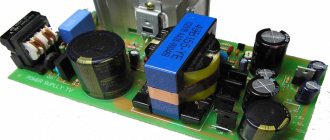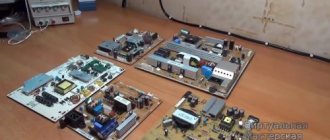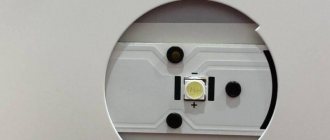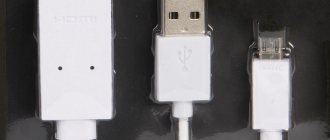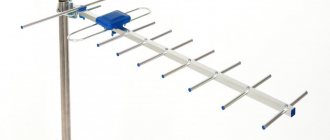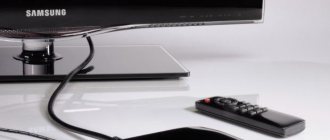Rubin is a company that produced high quality TVs during Russian and USSR times. In the Soviet Union, new technologies were introduced specifically into TVs of this brand. Any equipment can have problems, so rubies need to be repaired from time to time. There are a huge number of reasons why malfunctions occurred. That is why repairing a Ruby 55M06 TV is not a rare occurrence.
You can repair this TV yourself
Problems with the power supply
It is based on the TDA16846 chip (there may be variations). At first, when you turn on the device, the LED may blink a couple of times, and then go out completely. Here it is necessary to measure the horizontal scan voltage: it will gradually rise to 50 V. If you measure all other voltages, you will be able to verify that they are underestimated. Next, you can try to force the TV to turn on. To do this, you need to close the emitter and collector terminals on the BC548V transistor (in the VT 805 diagram). If the device starts to start, then the reason is the zener diode VD830 (it is located in the optocoupler D801), which has a high leakage.
Chip TDA16846
Malfunctions and their elimination on Ruby TVs
There are a huge number of problems that can happen with technology. Here is a list of some of them:
- uncontrolled change of memory cells;
- The power supply does not turn on or there are other malfunctions;
- standby mode is always on;
- image shift after several hours of work;
- non-existence of line scanning;
- increased voltage from power supply;
- may confuse commands from the remote control;
- failure to configure channels;
- presence of noise in picture quality;
- blinking screen;
- and other factors.
You can fix some of the problems yourself. Despite this, many of them cannot be corrected by a person who has little knowledge of technology. It is for this reason that many consumers take their TVs, including rubies, to be repaired by a specialist.
In this video you will learn more about repairing this TV:
Problems related to the power supply (PSU)
The basis of the functioning of the power supply is organized on the change in rectified network intensity into high-frequency oscillations with further conversion and acquisition of rectified voltages in secondary aggregates.
How the power supply works and looks like, its components
Before the 1970s, most consumer electronics used a power supply such as a power transformer, or rectifier, or filter capacitor to convert the AC line to the various voltage levels needed for internal circuits. Many of them were not even regulated.
Nowadays, all televisions, monitors, PCs, laptops, video cameras, printers, faxes and even certain audio equipment use switching power supplies.
Switching power supplies or switching power supplies (SMPS) are an electronic circuit that converts energy using:
- Switching devices that turn on and off at high frequencies;
- Storage components, such as inductors or capacitors, to supply power when the switching device is in a non-conducting state.
Switching power supplies have high efficiency and are widely used in various electronic sensitive equipment that require stable and efficient power supply.
Switching power supplies are classified according to the type of input and output voltages. Here are the four main categories:
- AC to DC;
- DC to DC;
- DC to AC;
- AC to AC,
where AC is alternating current and DC is direct current.
In direct current, electric charge flows in only one direction. The electric charge of alternating current periodically changes direction. The voltage in AC circuits also periodically reverses as the current changes direction.
Most modern digital electronics use direct current. However, it is important to understand some AC concepts. Most of our homes are connected to AC power, so if you plan to plug an electronic device into an outlet, you will need to convert the AC to DC.
Alternating current has its undeniably useful properties, such as the ability to convert voltage levels using a single component (transformer), which is why alternating current has been chosen as the primary means of transmitting electricity over long distances.
Now let's understand the working principle of different power supplies. A conventional (linear) power supply uses a transformer to change the voltage to the required level. The circuit then changes this to constant current, ensuring it is clean and remains at the proper level (rectification, filtering and regulation). The problem with this design is that the line frequency transformer devices are large, heavy and expensive.
The key to the operation of a switching power supply is to operate the transformer at a much higher frequency, most often beyond audible frequencies. At higher frequencies the iron core of the transformer is no longer needed, so the design is more compact, lighter and potentially more stable than the old linear design.
But in order not to go too deep into the technical jungle, let’s move on to more tangible parameters. What does a switching power supply for a TV look like and what components does its design consist of?
In modern TV models, power supplies are located on the system boards, and there are several of them, or rather, most often three:
- Power supply unit on duty;
- Inverter block;
- PFC block.
All these components are yellow-black in color.
The duty power supply is the device that is responsible for lighting the indicator on the front panel of the television receiver. It always maintains a minimum voltage of 5 volts so that the user can turn on the equipment from the remote control.
Inverter Unit – This system component is responsible for supplying voltage to the inverter converter. Inverters produce a fairly high voltage level for power (500 to 700 volts) and light up your LCD screen. A faulty or damaged inverter board may cause picture distortion, darken the screen, or prevent it from turning on. If a breakdown occurs in the inverter power supply, then your TV will go into standby mode immediately after turning on.
The PFC unit is the component responsible for correcting the power factor - the relationship between kW and kVA consumed by an electrical load, where kW is the actual (real) power of the load, and kVA is the total (nominal) power consumed by the load, which is not all used as effective energy. Simply put, it is a measure of how efficiently load current is converted into useful operating power.
When designing an AC-powered electronic power supply, strict adherence to PF limits and performance standards is required. This is typically achieved by introducing an active or passive power factor correction (PFC) circuit within the power supply.
As can be seen from the description, the TV power supply is not just a separate device that can be easily replaced (although there are such TV models). This is a whole unit that consists of several components, each of which is responsible for its own direction in providing the receiver with a voltage of a certain power.
Doesn't turn on
There are several reasons and solutions for the fact that the Ruby TV does not turn on:
- High CPU voltage. First you need to check the functionality of this part. If this is the problem, it needs to be replaced to avoid further problems.
- Microchip malfunctions. There are microcircuits located on the frame scanning board of the ruby TV. Signs of their failure may include tarnishing of the printed circuit board and, possibly, microcracks within the radius of the parts.
- Improperly soldered highway. The ruby works fine from the very beginning, but may stop functioning after 2 to 3 years of use due to this error.
Turns on and off immediately
There are several problems with the fact that ruby starts to turn off, or turns off after a while, or can turn off immediately after loading. The TV may turn on and off immediately due to:
- Sticking buttons on ruby. In this case, you just need to check whether the TV turns on from the button on the TV itself.
- Invalid ruby functional setting. Due to the fact that many TVs support upgrades that are affected by the device turning off when there is no signal, there is a chance of this problem occurring.
- Accidentally downloaded program. The user may not specifically install and configure a program that will turn off the ruby's power after, for example, three minutes or 10 seconds.
To configure ruby, you need to go to the technology menu, find the options there:
- geometry;
- settings;
- options;
- reset
If you need to enter this menu, you should put the TV into standby mode, then press the “menu” button on the ruby and “0” on the remote control at the same time.
Don't forget to follow the reset instructions
No sound
If there is no sound on the ruby, you need to dig into it. First you need to use an AC voltmeter to examine the presence of an audible frequency signal. In its absence, the serviceability of the modules, microcircuits and submodules is analyzed.
If the withstand voltage of chip D1 is between 10 and 12 W, you need to check circuit D2. The interference may be located in the control unit. There is a possibility that it is caused by uncontrolled sound correction stress. There may be no intensity due to interference in the microcircuits, capacitor or resistors.
Perhaps the ruby TV whistled at first, but did not completely lose sound.
Image problems
Correcting image problems should be started only after you are convinced that the TV’s power supply and scan generator are working properly. If the problem is in the picture, you need to contact the output video amplifier. If at least one of the connection channels is working, information will be displayed on the display when responding to the buttons installed on the remote control and the ruby itself. If there is a malfunction in the power supply circuits or failure of the D201 IC, the image becomes completely inoperable.
Severe picture noise comes down to the fact that the sensitivity of the TV is reduced. To correct it, it is necessary to consider automatic gain control, which may be unstable due to insufficient intensity at the output of the channel selector.
The predominant color on ruby is green
If you have this problem, you need to try the following methods:
- reduce the colorization to the minimum value, checking whether there is a green tint in non-color images. In the case where there is a tint in both versions of the image, you need to adjust the white content by adjusting the ranges and levels of the primary colors (red, blue, green) of the video amplifiers. Regulation is carried out in the lowest and highest brightness positions;
- If a colorless image is transmitted as expected, and a color image is transmitted with a green fill, there is a problem in the chromaticity block - zero discriminants are “disappeared”. A black and white signal is needed for regulation; the color channel should be unlocked. Set the outline of discriminants to optimally convey a colorless picture.
Horizontal stripe
The stripe on the ruby display is a breakdown that ranks 3rd in terms of frequency of malfunctions. An error occurs in the functioning of the screen in the form of a stripe on the screen about 3 - 4 cm, usually bright compared to the rest of the image. It can be caused by factors such as:
- damage to the personnel chip;
- malfunctions in the system of capacitors piping KM;
- lack or deficiency in CM nutrition;
- microcracks on the frame scanning device.
First you need to check the microcircuit.
All this can be fixed. The main thing is to find the problem itself, due to which the Ruby TV is not working properly. First you need to check the microcircuit with its wiring, since this is the simplest. Next, we consider the availability of power. Most likely the problem will lie in these two factors.
Important! Here we consider only a horizontal stripe, but it can also be vertical.
No image available
It happens that there is sound, but no picture, and the green indicator blinks. This is usually associated with mechanical damage, such as impacts, falls. The performance of any TV is also affected by physical malfunctions acquired as a result of moisture or sunlight getting on the display.
For example, Ruby stopped turning on when starting with a wet screen. The most obvious is a manufacturing defect, which can manifest itself some time after use. No one is immune from this breakdown; televisions of all brands are subject to such inconveniences.
When loading a ruby, a splash screen with the name of the brand may first appear, after which the sound will work, but not the picture. To get started you need:
- check that the power cord is securely connected to the outlet;
- examine the cable for any faults. They may not be obvious, but even this affects the quality of the image, its presence or absence;
- It is possible that when the sound volume is increased to maximum, a picture may appear. After “fixing” the volume can be adjusted back to the optimal level.
More complex breakdowns include:
- malfunction of the investor providing the backlight lamps with the proper voltage;
- failure of the lamps themselves. This may lead to more serious consequences - failure of the power supply;
- incapacity of the matrix, system board, cables and other parts.
Important! All breakdowns cause discomfort in their own way. It is not recommended for a person who has no idea how a ruby works to try to repair it themselves. To do this, it is best to call a repairman.
